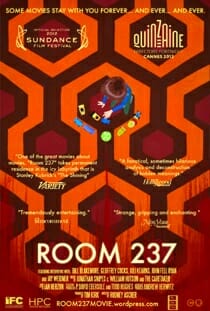Room 237

There exists a rare species of obsessive moviegoer, the hyper-fan who focuses on one film, mentally and emotionally ingesting it dozens, maybe hundreds, of times. Along a certain parallel, there is also a serious breed of conspiracy theorist, compulsive in his or her beliefs, taking things far beyond just watching Doomsday Preppers for fun. Put these two types together, and you get Room 237, the confounding, eye-opening, and often hilarious documentary about individuals whose over-wired brains are devoted to one cinematic masterpiece: Stanley Kubrick’s The Shining.
Seen Kubrick’s polarizing film a bunch of times? Think you know The Shining inside-out, the quotes, the symbolisms, the whole shebang? You’ve got nothing on the stars of Room 237. Using a chapter-by-chapter format, director Rodney Ascher introduces each Shining theorist and his or her obsession with the film—yet, the contributors never appear on camera. As a result, the actual footage from Kubrick’s oft-debated film is onscreen throughout, with each painstaking dissection voiced over by its originator. These super-viewers, mesmerized by the movie’s minutiae, are the only storytellers of Room 237 (save for the The Shining itself, of course), and what strange storytellers they are. If there were a Shining fan convention, you could imagine them all coming dressed in the rabbit costume. (Okay, some would arrive as Mr. Ullman or Lloyd the bartender.)
The most outlandish—and perplexing—theories in Room 237 posit The Shining either as a vehicle meant to comment on dark, oppressive periods in history, or as a massive, cryptic revelation. In the first category, there’s the fan who believes Kubrick is making a statement on the condition of the Native American Indian, leaning as proof on the persistent presence of Calumet brand baking powder containers that feature the profile of a Native American.